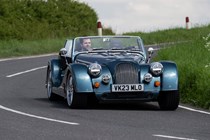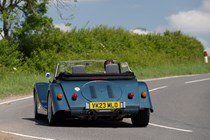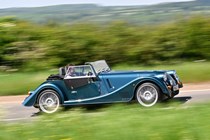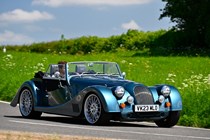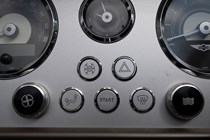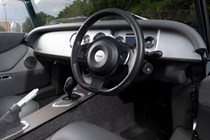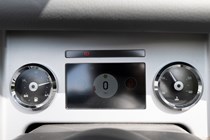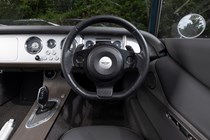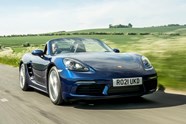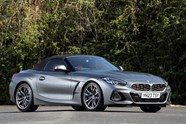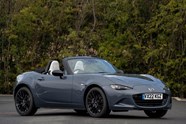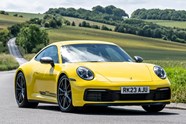Morgan Plus Six Convertible review
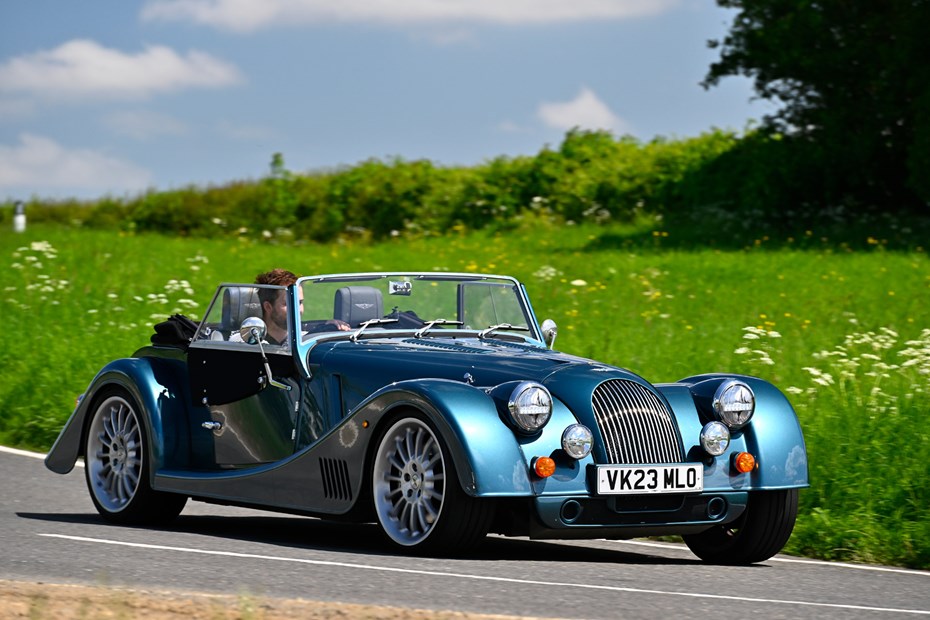
At a glance
| Price new | £84,240 |
|---|---|
| Road tax cost | £195 - £620 |
Get an insurance quote with

|
|
| Fuel economy | 34 mpg |
| Miles per pound | 5.0 |
| Number of doors | 2 |
| View full specs for a specific version | |
Available fuel types
Petrol
Pros & cons
- BMW 3.0-litre turbo makes it seriously fast (0-62mph in 4.2)
- ‘Coach built’ design is nicely finished and highly customisable
- Electronic stability control and other modern niceties
- Roof requires a touch more patience than many convertibles
- Not as sharp in the corners as better-known sports cars
- Very little luggage space, some creaks, some drafts
Morgan Plus Six Convertible rivals
Overview
Do not adjust your internet: this is still 2024 and you are still looking at Parkers.co.uk, and the Morgan Plus Six I’ve been driving here deserves to make its presence known entirely within this context. For although it has the visual impact of something from the 1950s, this is a brand new car, powered by a modern BMW engine.
Before Morgan gets on the phone to complain I’m being a little too flippant, I should explain how taken aback I was by the sheer number of people who stopped to ask about the Plus Six while it was in my possession. And that a lot of them stopped because they had absolutely no idea what it was, nor how such a classic-looking sports car could be wearing a current number plate.
This was a surprise – and an eye-opener – to me, for as a car enthusiast I’ve been aware of Morgan pretty much since I could say the word car. So although this is the first Morgan I’ve ever driven, I came to it well aware of this fabled British brand. But for the general public it flies very much under the radar.
And boy does the Plus Six fly. The BMW engine is the same 3.0-litre TwinPower turbo fitted in a number of that firm’s M Performance models and it produces 340hp. This isn’t some kind of retro pastiche. It’s a hot rod.
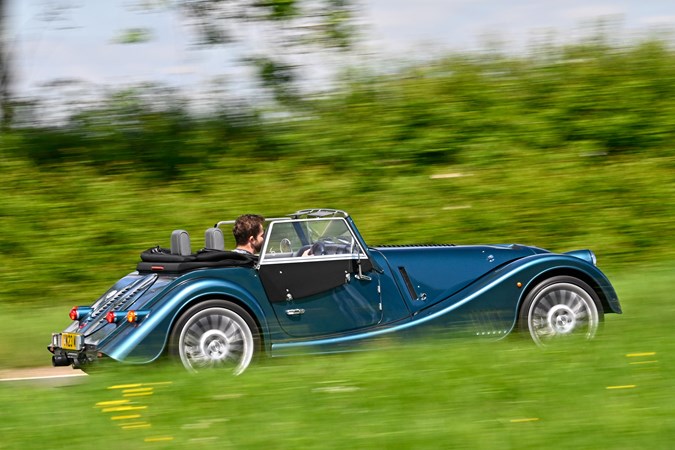
It’s also a lot more modern than you might expect. For decades, Morgans were built using traditional wood frame techniques, but the latest Plus Six – which was most recently updated for January 2023 production – uses the company’s CX-Generation bonded aluminium platform. It also features such niceties as Electronic Stability Control (ESC), twin airbags and AP Racing brakes.
So while you will find wood in places – not least the bar that runs the whole width of the bottom of the formed aluminium dashboard – this is a car with ambitions to be more than just something pretty to look at. It’s the current top of the Morgan product line, too; a wider, more inclusive choice than the related Plus Four, with styling intended to be ‘more assertive’.
You can find out more about how we test on Parkers via our dedicated explainer page. But in the meantime, climb in and let’s go for a ride.
What’s it like inside?
Before you get inside you’ve got to negotiate the roof. My general rule of thumb for driving a car like this is that anything short of a typhoon, the roof should be down. Here this involves poppers, some slightly stubborn catches (at their worst when you’re putting the roof back up, as denoted by the already missing paint on the top of the window frame of this 10,000-mile-old press car), and a manual folding process that requires a little patience. You need to avoid the headrests and then re-popper the side sections to stop them flapping about in the breeze. Takes a couple of minutes.
Speaking of breezes, if you are forced to drive with the roof up, dress well – there’s quite a draft that blasts in by the door shuts, drawing plenty of ‘arctic elbow’ comments from my passengers. Rear three-quarter visibility is quite reduced, also, something that’s made more challenging by the tiny door mirrors. The driver’s side one was in a constant state of vibration during the test period, and for the life of me I couldn’t figure out if there was a way to tighten it up; the passenger side was fine.

As with all sporty convertibles, driving roof up does mute the appeal of the car. It seems perfectly weather resistant, which is good news, but any opportunity to drive with the roof down should be taken. It just brings you closer to your environment and increases the unique sensations involved with a car like this one. Tally ho, parp, parp, etc.
On the other hand, with the roof down even the slightest hint of precipitation conspires to get the inside of the windscreen dirty. The natty triple wipers do a fine job of the outside, but I still found myself losing a bit of visibility, despite the aerodynamics managing to keep most of the rain away from my person.
It’s also a good idea to get familiar with the controls before you set off, as the Morgan relies on buttons for secondary functions, not all of which are easy to decode at a glance, some of which are hidden. There is a digital screen, but it’s just for driver info and placed behind the uncluttered steering wheel. The surrounding analogue dials are beautiful to look at – though the speedo and rev counter are in the middle of cabin, rather than in front of you.
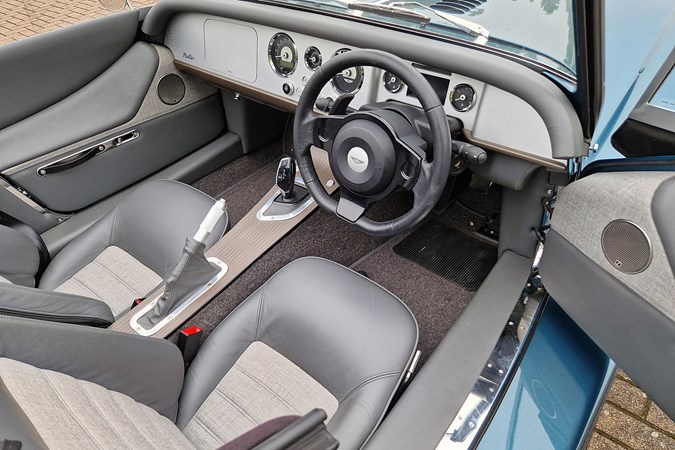
Quality inside is generally rather lovely, albeit in a handcrafted rather than mass-manufactured way. Neat features include the ‘rifle-bolt’ door release mechanism, which was new for the 2023 update. The only poor-fitting item was the shroud for the steering column, though the fixed paddleshifters and the stalks for the indicators and wipers are a little plasticky.
You might have noticed there’s no obvious radio or hi-fi system, the Plus Six instead relying on a hidden a Bluetooth stereo, upgradable – as tested – with Sennheiser components for an extra £2,995. Connecting to this is dead simple via your phone, and it’s just about powerful enough to be heard at legal motorway speeds. You have to fish about under the dashboard for the rotary volume control but it’s not difficult to find or operate.
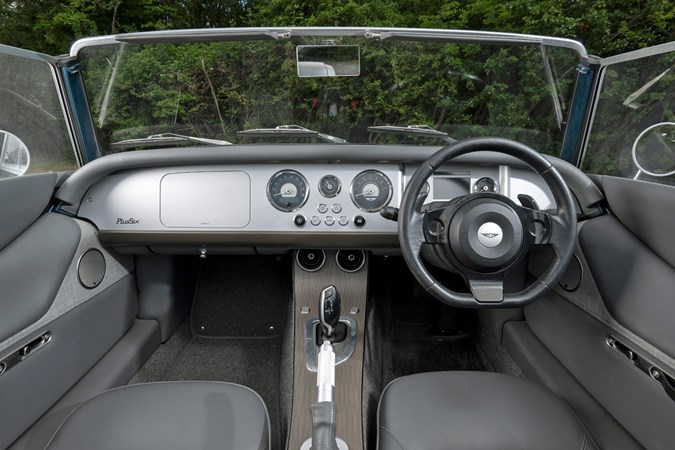
Boot space is basically non-existent. There is a small (really small) area behind the seats, but if you want to take weekend trips away with a passenger you’ll need a rack on the back and waterproof luggage; don’t forget to option the luggage rack preparation kit from the factory. Morgan offers a luggage rack that includes storage for the side screens, too – these are the removable top portions of the doors. Whatever solution you go for will need to clear the fuel filler that’s also located back there. I found this charming to use, but others may feel it’s a little faffy.
This Plus Six is the first of its kind to come with a glove box. Don’t get too excited. It is tiny, and tended to fall open when confronted with anything heavier than a notebook. It’s worth investigating, though, as you’ll find USB ports for charging your phone hidden inside. A cupholder (singular) and a storage pocket are also available as optional extras.
Comfort
It’s cosy in the cabin, but not actually cramped for my 5’ 11” frame – that’s one of the benefits of upsizing to the Plus Six over the Plus Four. There’s not a huge amount of adjustment in the steering wheel position but the seats are well finished and I was able to complete multiple-hour journeys without feeling like I needed to be straightened back out with a set of spanners at the end.
It is louder than a conventional car. With the roof down there’s plenty of rushing wind to contend with and the high stereo volume if you actually want to listen to something other than the engine and exhaust (upon which more in a moment). With the roof up you get a little more road noise but are isolated from the blasting air and can listen to music at lower volumes.

I found the heater more than good enough to stop me freezing while driving in the drizzle at night. However, for aesthetic reasons Morgan cunningly hides the heated seat switches even further under the dashboard than the volume control – and locating the driver’s one when travelling at 70mph was initially beyond me. A little more familiarity is all that’s needed there.
Suspension comfort is covered in the driving section below.
Safety
There are twin airbags as standard – one in the steering wheel, one in the passenger dashboard. Doesn’t sound like much, but apparently exceeds the homologation requirements for this kind of low production volume vehicle.
Also new for this Plus Six is the standard Electronic Stability Control, adding a welcome layer of reassurance given the performance and structure. This is sophisticated enough that it can be varied with the driving mode. I found the AP Racing brakes to be well up to the task of slowing the Morgan down in confident fashion.
There are no other safety aids or assistance systems. But that is the sort of thing buyers of these kinds of cars tend to applaud.
What’s it like to drive?
The first point to get across here is that the Morgan Plus Six is fast, fast, fast. It may look like a 1950s roadster of venerable persuasion but it is powered by a rather lovely current-generation BMW straight-six engine with a lot of turbo – it’s not so much that you can leave other motorists (including the one in the Golf R who was just tailgating you) gasping in surprise, but rather that it’s so fast they disappear behind you quickly enough that you can’t even tell what expression they’re wearing.
In raw numbers, the Plus Six will do 0-62mph 4.2 seconds and has a claimed top speed of 166mph. The standard eight-speed automatic transmission, 369lb ft of torque (pulling power) and sub-1.2-tonne weight means acceleration once you’re already moving is even more impressive than the figures suggest. I can’t even begin to imagine what well over 100mph would feel like, but the answers are certainly ‘noisy’ and ‘mind-focusing’.
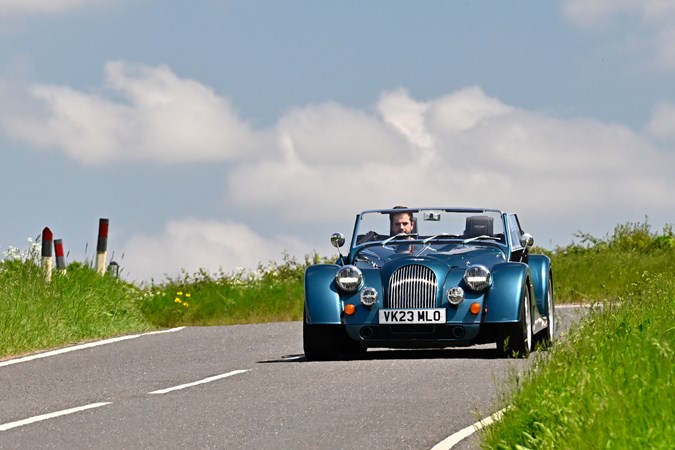
For though it is more than capable of cooking most UK traffic, it’s still an open-top car hand-assembled by (highly-skilled) people in what is fundamentally a shed – and it doesn’t quite have the structural integrity of, say, a Porsche 718 Boxster S, which will also do 0-62mph in 4.2 seconds. And thus, even without a huge amount of steering feel, you do feel decidedly involved in every moment of the experience.
Yes, this does translate into some curious creaks at times, but you can drive the Plus Six both quickly and comfortably. The automatic gearbox – and especially the BMW lever that controls it – tends to draw criticism from enthusiastic purists. But the presence of this and the paddleshifters on the steering column is representative of the wonderful melding between old and new here.
The same transmission that BMW uses, though retuned for the Plus Six, is smooth, quick to react and great fun to play with via the paddles. Particularly in the sportier settings, as these also make the exhaust sounds more entertaining, with lots of pops and crackles whenever you lift the accelerator. This is the sort of thing that’s quite annoying when an oik in a modified hot hatch creates a similar racket outside my house in the middle of the night, but in the Morgan only serves to further the charming incongruity between appearance and performance.

To look at the car it’s fairly obvious that you’re sat practically over the back axle, so it was hardly a shock that it gave me the occasional bang in the bottom over bumpier tarmac. Morgan is unsurprisingly wise to this by now, so the set-up is not overly firm, allowing the tyres to maintain as much contact as possible with the road surface. I still found myself being juddered about a bit at times, but I never felt it was overwhelming. On the motorway it’s remarkably calm and soothing to cover distances in, although the 46-litre fuel tank means relatively frequent stops.
Similarly, though there’s a bit of body roll and the front end of the car isn’t as pointy as more conventional performance machinery at this kind of price level, but I soon found myself learning to drive around and with these foibles rather than be limited by them. Fat rear tyres mean that traction is rarely an issue and going quickly in this is far more visceral than it is in most similarly powerful kit. Again, while it doesn’t deliver the ‘perfect’ performance ideal a lot of modern car buyers have come to expect, this is all part of the Plus Six’s character.
And character – coupled with such otherwise modern performance – is exactly the reason I’d consider buying a car like this instead of the more conventional alternatives. It’s an instant talking point, a conversation starter, a means of making driving fun again.
Ownership costs and maintenance
Well, the low weight only gets you so far with this engine, so you can expect to be chucking plenty of fuel down the throats of those six cylinders. Morgan reckons it’ll do 34mpg – which is probably true. If you’re a saint. I’m not, and was in the 20s. CO2 emissions are officially 180g/km.

You might also be thinking servicing and maintenance is going to be a pain in the neck, and yes it won’t be as straightforward as popping to the local Porsche dealer, let alone looking after the family Ford. But Morgan sets a standard some mainstream manufacturers would do well to follow and has an easy to understand servicing webpage and an interactive map showing the location of its dealers.
The Plus Six requires a service every 12 months or 10,000 miles. The standard warranty is for three years or 36,000 miles.
What models and trims are available?
There’s only one version of the Plus Six, but a vast array of finishing options ranging from choices of veneer to the stitching on the seats and so much more in between means you’ll be able to craft something very much bespoke to you. Enjoy the process.
What else should I know?
Well, we haven’t talked about the price. It starts at £93,603.40 on the road, and the example tested ran to £110,585.79 with options. That’s a pretty serious amount of money considering the other fun cars you could buy for that amount. It would, for example, get you into a Porsche 911, let alone a Boxster.
But you can also expect to be joining a lengthy waiting list if you do decide to ‘commission’ a Plus Six, which suggests Morgan’s customers know exactly what they want and are prepared to pay what it costs to get it. Not much point making comparisons here.






